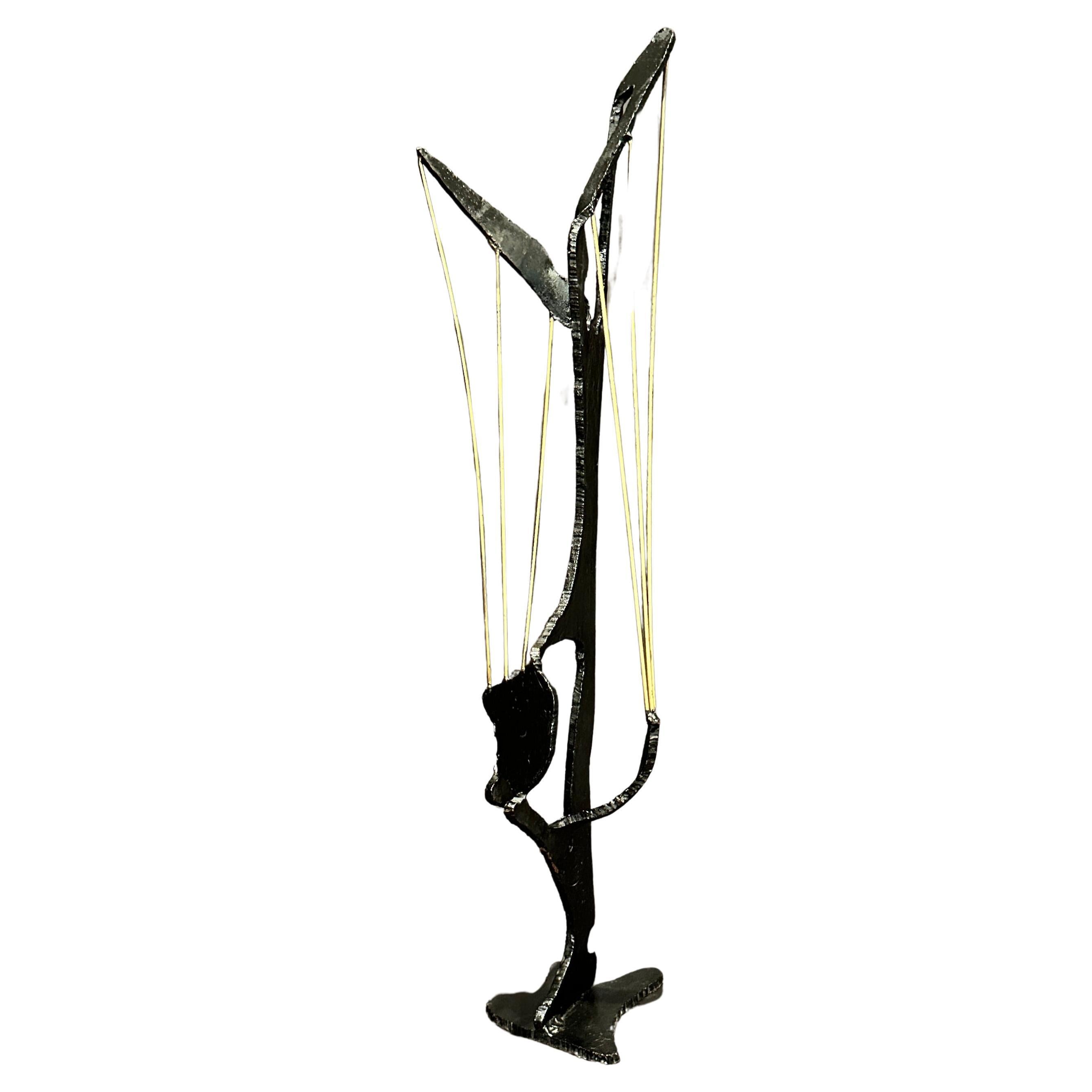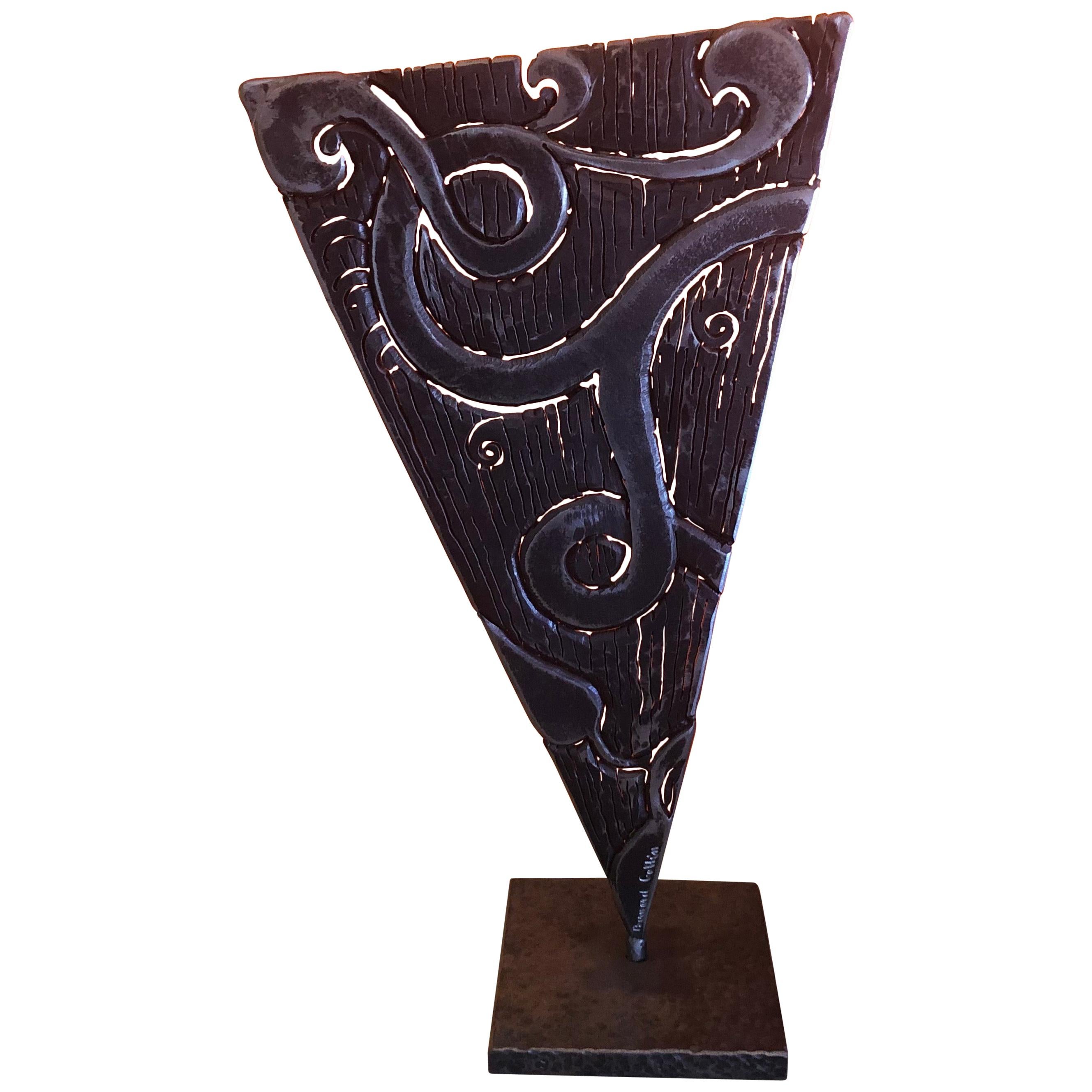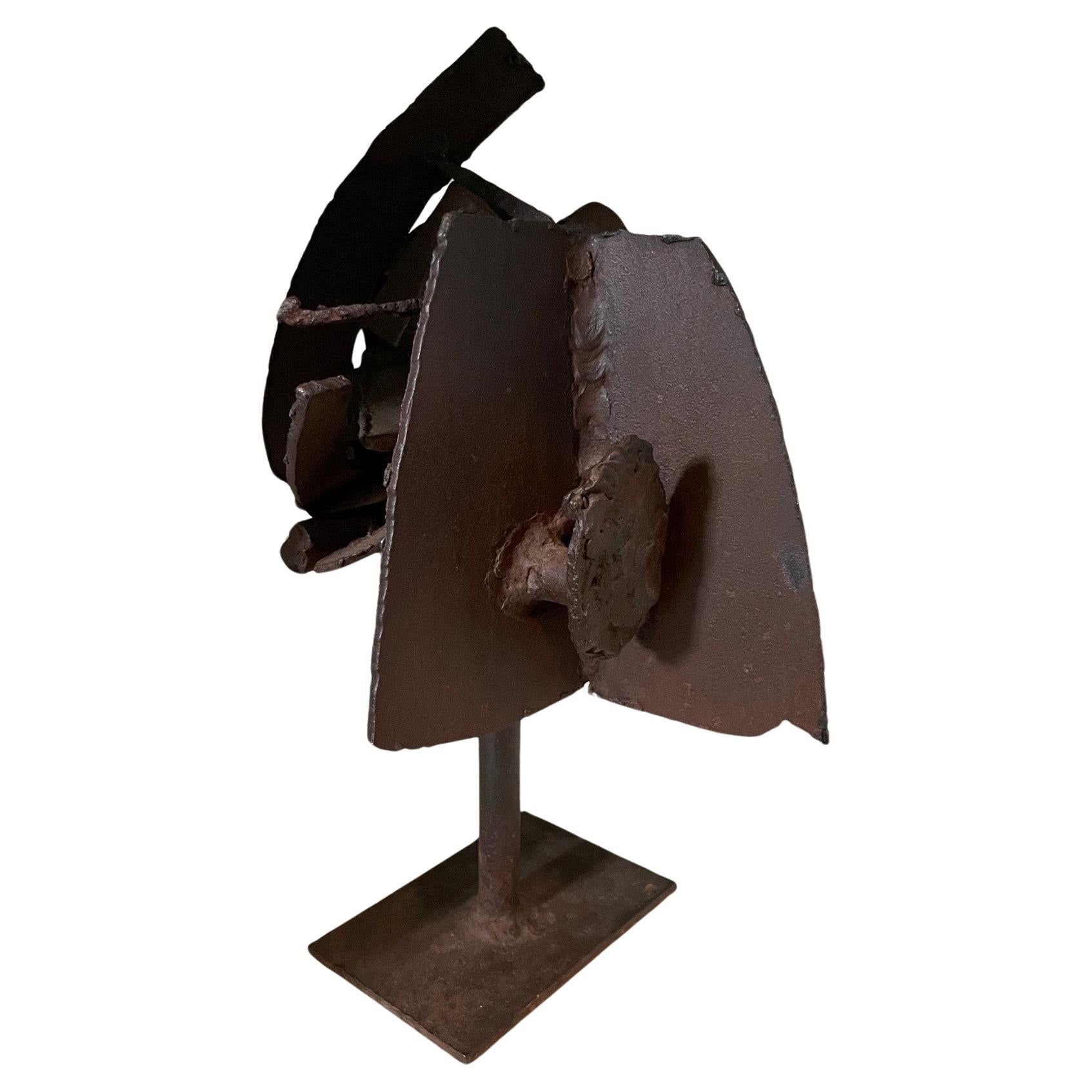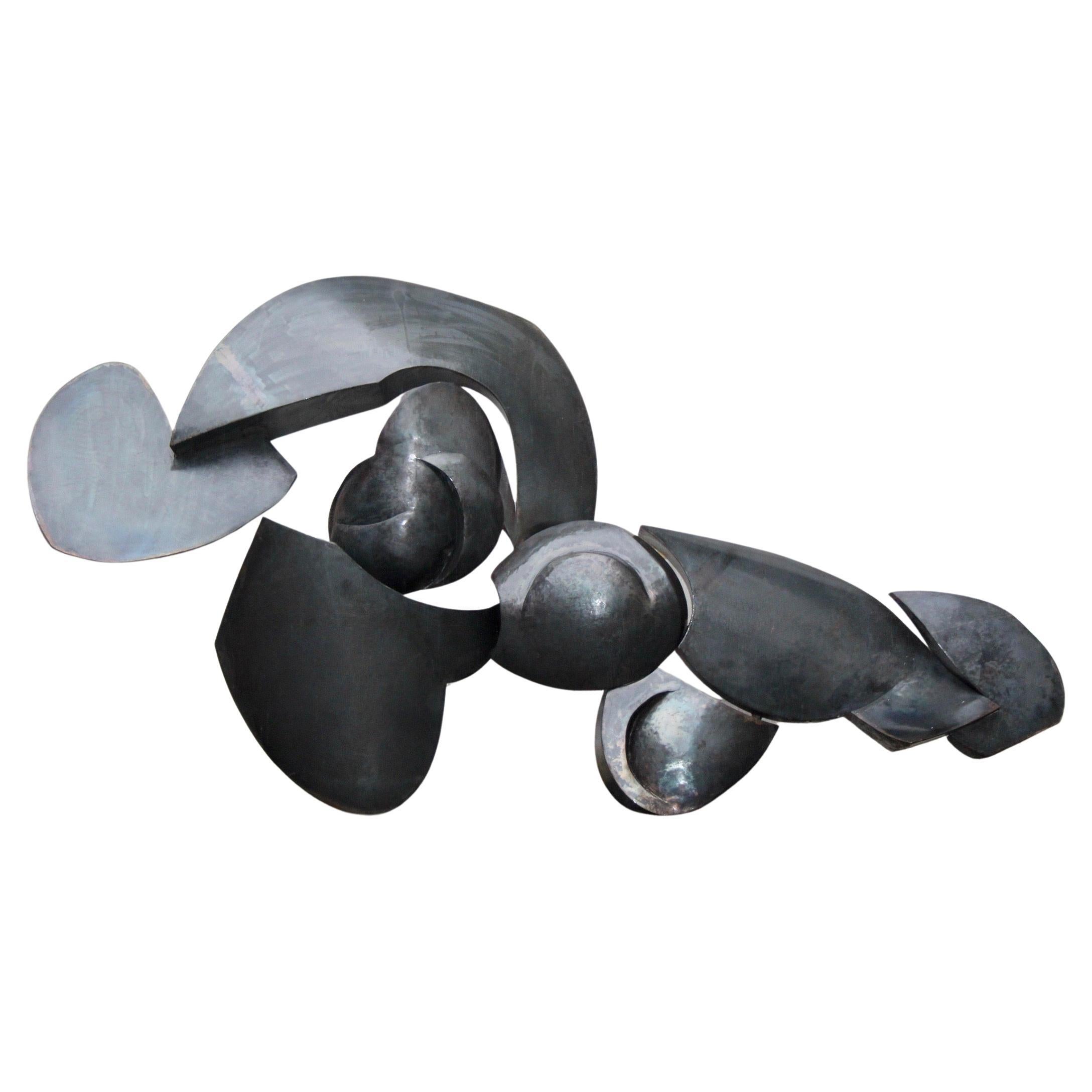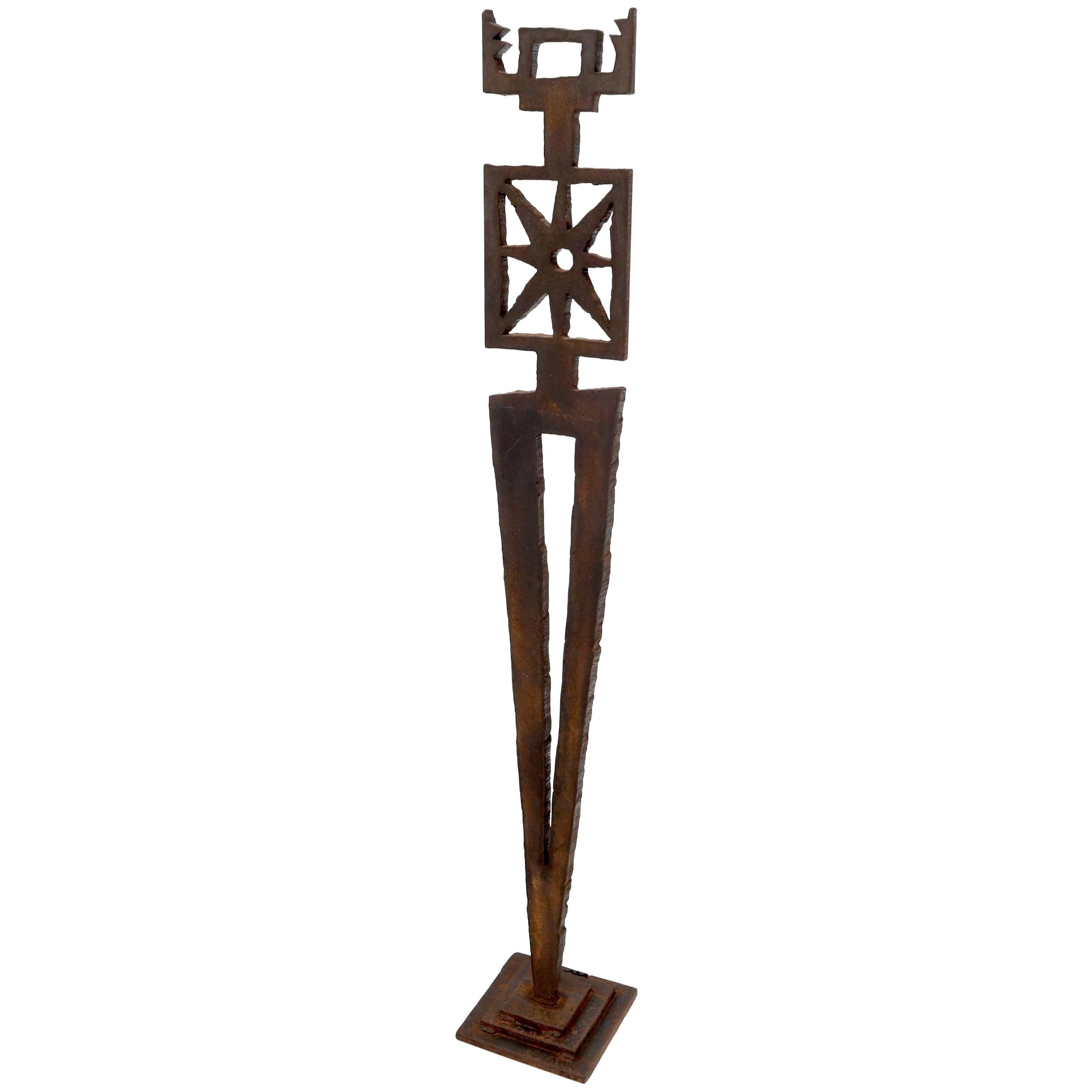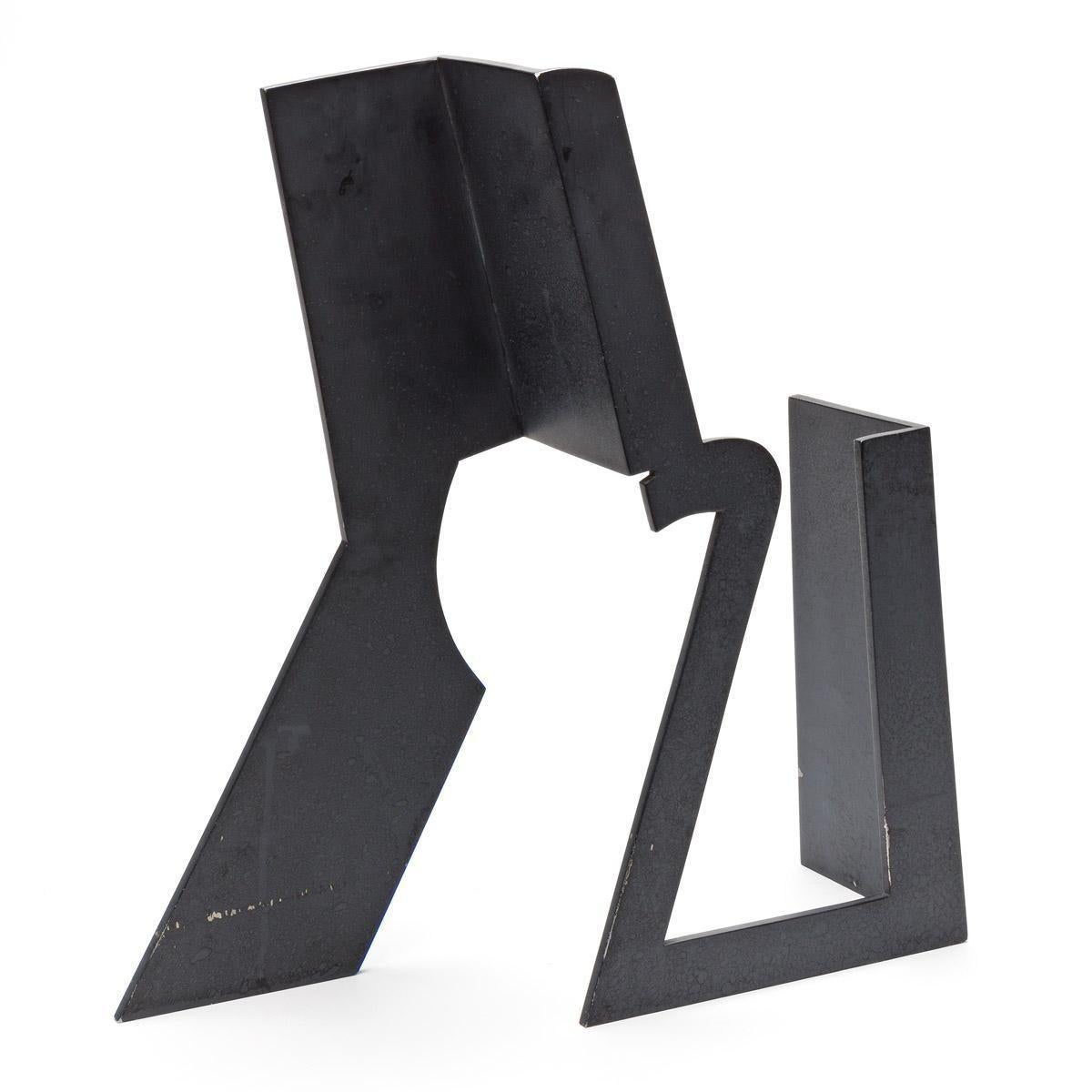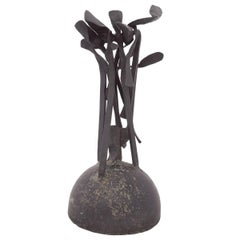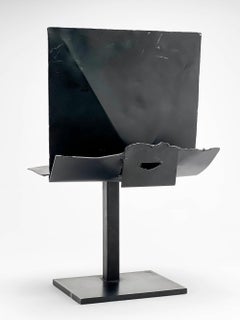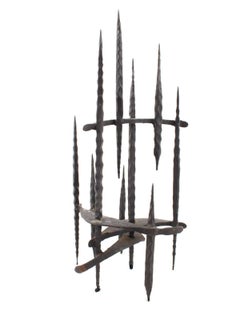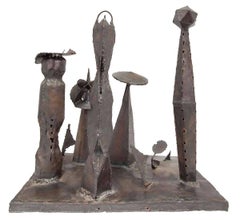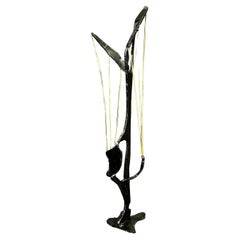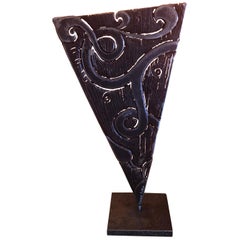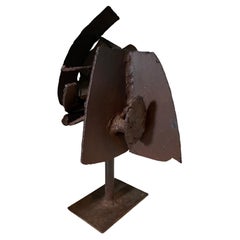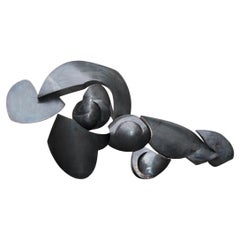Items Similar to Large Mario Almaguer Cuban Art Welded Painted Steel Abstract Sculpture Modernism
Want more images or videos?
Request additional images or videos from the seller
1 of 12
Mario AlmaguerLarge Mario Almaguer Cuban Art Welded Painted Steel Abstract Sculpture Modernism2005
2005
$3,600
£2,729.72
€3,131.92
CA$5,122.36
A$5,556.60
CHF 2,921.97
MX$67,612.62
NOK 36,529.36
SEK 34,451.67
DKK 23,383.81
About the Item
Mario Almaguer (b. Marianao, Cuba, 1955) He moved to the U.S. in 1994 to Miami where since has been living and working. Essentially self-taught, he embraced sculpture as his mean for expression. Without any kind of formal academic education or training in the arts, perseverance and praxis made him an artist. His work has been influenced by cuban master Agustin Cardenas and british Henry Moore. In his early years until 1994 he produced a large amount of small and medium scale wooden sculptures. From 1994 to the present, Almaguer creates and produces steel sculptures. It's with his works on steel where he encounters a strong expression with a striking liberty hard to deliver in wood. His monumental sculptures were recently exhibited at Miami Dade College, where his colossal pieces are joined to the campus buildings. Almaguer's work is in collections in the U.S. and abroad. He has exhibited in the U.S. and Latin America and is subject of several articles.
He was in the two man show OFF THE WALL Steel and Glass by Mario Almaguer & Carlos Marcoleta. Almaguer’s work uses allusions to the human figure, and particularly those components of the anatomy which are most strikingly symmetrical or geometric. Eyes, the vulva, mouth recur in the drawings realistically, in the sculptures in stylized form. In both media, Almaguer broadens the totem as a compositional concept, subtly linking the standing figure to the vertical syntax that connects elements. Other allusions are produced simultaneously with the above, to tools, mechanical instruments, and machines, as well as to exoskeletons, tentacles, pistils, synapses, among other components of organisms. The convergence of the mechanistic and the anatomical has a precursor in Cuban art: the paintings and drawings of Latin American Agustin Fernandez (1928-2006), in which flesh, armor, grills, leather, razors, lace, flaps, cords, belts, among other elements, come together in novel if often unsettling ways. Another important precursor is the Chilean Roberto Matta (1911-2002) whose insect, machine-like figures emerge in the luminous landscapes of the unconscious. However, Almaguer uses the multidimensional biomorph independently of context, as an almost ritualistic construct which is also a giant flower that is a face, a weapon, a trap, and a navigational instrument. . . . And unlike in Fernández’s work, an almost flirtatious humor runs through Almaguer’s pieces. They make us recall fantastic machines and sets of early sci-fi films, as well as monstrances and other extravagantly fancied liturgical objects. In all, Almaguer’s art is thoughtful, humorous, and sensuous.
SOLO EXHIBITIONS
2004-Monumental Sculpture, Miami Dade College, FL.
2003-Wood Carvings,Miami Dade College, FL.
1994-Punto de Partida,Centro Provincial de Artes Plásticas y Diseño, Havana .
1993-Tallas de Madera,Galeria Servando Cabrera Moreno, Havana .
1992-Tiempos de Cambio, Libreria La Moderna Poesia, Havana .
1991-Tallas de Madera , Centro de Arte 23 & 12, Havana .
1991-Formas de Hierro, Galeria Enrique J. Varona, Havana .
1991-Formas de Hierro, Galeria Wifredo Lam, Havana .
1991-Formas de Hierro, Gran Teatro de La Habana.
GROUP SHOWS
2012-Artopia Art Center, Miami, Fl.
2011-Miami Art Basel, Miami Beach, Fl.
2009-31 Escultores Cubanos, MDC West, Doral, Fl.
2002-37 of Miami's most Creative Artists, University of Miami , School of Continuing Studies .
2002-Homage to the Virgen de la Caridad, Fraga Fine Arts, Miami .
2001-Art of Cuba,Maxoly Gallery, Miami .
2000-Association of Sculptors of South Florida .
1999-Cuba,The Florida Museum of Hispanic and Latin Art, Miami .
1998-The Florida Museum of Hispanic and Latin Art, Miami .
1997-General Consulate of Mexico , Miami , FL.
1997-Bird Road Art Connection, Miami, FL.
1995-Universidad Cartagena de Indias , Colombia .
1993-Salon 13 de Marzo, Universidad de La Habana.
1992-ACCA Group Show, Calle Obispo head office, Havana .
1992-Salon Nacional de Cultura, Centro de Desarrollo de las Artes Visuales.
1991-IV Salon "Mirta Cerra", Bejucal, Havana.
1991-Jornada de la Cultura Cubana, Galeria Wifredo Lam, Havana .
- Creator:Mario Almaguer (1955, Cuban)
- Creation Year:2005
- Dimensions:Height: 33 in (83.82 cm)Width: 9.5 in (24.13 cm)Depth: 6.5 in (16.51 cm)
- Medium:
- Movement & Style:
- Period:
- Condition:minor wear commensurate with age and material.
- Gallery Location:Surfside, FL
- Reference Number:1stDibs: LU38214459812
About the Seller
4.9
Platinum Seller
Premium sellers with a 4.7+ rating and 24-hour response times
Established in 1995
1stDibs seller since 2014
1,815 sales on 1stDibs
Typical response time: 1 hour
- ShippingRetrieving quote...Shipping from: Surfside, FL
- Return Policy
Authenticity Guarantee
In the unlikely event there’s an issue with an item’s authenticity, contact us within 1 year for a full refund. DetailsMoney-Back Guarantee
If your item is not as described, is damaged in transit, or does not arrive, contact us within 7 days for a full refund. Details24-Hour Cancellation
You have a 24-hour grace period in which to reconsider your purchase, with no questions asked.Vetted Professional Sellers
Our world-class sellers must adhere to strict standards for service and quality, maintaining the integrity of our listings.Price-Match Guarantee
If you find that a seller listed the same item for a lower price elsewhere, we’ll match it.Trusted Global Delivery
Our best-in-class carrier network provides specialized shipping options worldwide, including custom delivery.More From This Seller
View AllMid Century Modern Brutalist Welded Abstract Expressionist Sculpture
Located in Surfside, FL
Neo-Dada Abstract Sculpture: Assemblages
In contrast, abstract sculpture followed a slightly different course. Rather than focusing on non-figurative subject matter, it concentrated...
Category
Mid-20th Century Abstract Expressionist Abstract Sculptures
Materials
Metal
1982 Argentine Metal Sculpture "Serie De Los Sobres" Maria Simon
Located in Surfside, FL
María Simón
Argentinian (1922-2009)
Untitled (from Serie de los Sobres)
1982
welded and enameled black sheetmetal sculpture
Escultura en metal, moldeado, soldado, esmaltado
18 1/4 x 11 1/4 x 8 1/2 inches
Provenance:
The Graciela Kartofel Collection
María Simón Padrós (1922 – 5 July 2009) was an Argentine sculptor.
Simón was born in Aguilares, Tucumán in 1922. Her father, John Simon Padrós, was an engineer, a prominent politician and industrialist; her mother was Emilia Dublé. Today she is represented in the collections of the Museo Moderno and the Museo de Bellas Artes, where one of her sculptures is on display until the end of July, along with others by Noemí Gerstein...
Category
1980s Abstract Figurative Sculptures
Materials
Metal
Mid Century Brutalist Iron Sculpture, Israeli Master David Palombo
By David Palombo
Located in Surfside, FL
Hand Forged Iron Candelabra
Holocaust Memorial Judaic Menorah Sculpture
David Palombo was an Israeli sculptor and painter. He was born in Turkey to a traditional family and immigrated to the Land of Israel with his parents in 1923. They lived in the Nahalat Shiva neighborhood of Jerusalem. In 1940 he began his studies at Bezalel Academy of Arts and Design, and from 1942 was a student of sculptor Ze’ev Ben-Zvi. For a period of time, Palombo was an assistant at Ben-Zvi’s studio and also taught at Bezalel. During this period he was also a member of the “Histadrut HaNoar HaOved VeHaLomed” (The General Federation of Students and Young Workers in Israel). In the 1940s he took art lessons at night. In 1948 he went to Paris, where he visited the studio of the sculptor Constantin Brancusi whose work influenced him. Around 1958 he married the artist Shulamit Sirota. In 1960 he quit his job to devote himself to art. In 1964 he married for the second time to the artist Yona Palombo. The two of them went to live in an abandoned home on Mount Zion in Jerusalem. In 1966 he was killed when the motorcycle on which he was riding ran into a chain stretched across the street to prevent the desecration of Shabbat. His widow opened a museum in their home that was active until the year 2000.
Work by Palombo is included in the Judaic collection of the Jewish Museum (a well known Hanukkah menora). Palombo executed the impressive metal gates of the Tent of Remembrance at the Yad Vashem, the memorial to the martyrs of the holocaust, as well as the gates to the Knesset Building the United Nations Educational Scientific and Cultural Organization (Unesco award) awarded him a scholarship for study in Japan. He worked in marble, granite, bronze, iron and steel. as well as with glass mosaic tiles. Palombo’s early works, in the 1950s, were influenced by modernist sculptors such as Brancusi. These works were composed of abstract images from nature and were carved out of stone or wood. At the end of the 1950s he began making metal sculptors, using the technique of welding. His work took on a more abstract and expressive character.
Education
1940 Painting with Isidor Ascheim, New Bezalel School for Arts and Crafts, Jerusalem
1942 Sculpture with Zeev Ben Zvi, Jerusalem
1956 Mosaic, Ravenna, Italy
1958 Welding Course
Awards And Prizes
1966 UNESCO Award
Exhibitions:
Sculpture in Israel, 1948-1958 Mishkan Museum of Art, Kibbutz Ein Harod
Artists: Zvi Aldouby, Yitzhak Danziger, Arieh Merzer, Dov Feigin, Aaron Priver, David Palumbo, Menashe Kadishman, Kosso Eloul, Yehiel Shemi, Zahara Schatz.
The Spring Exhibition of Jerusalem Artists, Artists' House, Jerusalem
Artists: Palombo, David Bezalel Schatz, Mordechai Levanon, Fima, Ludwig Blum
12 Artists, The Bezalel National Museum, Jerusalem
Avraham Ofek, Aviva Uri, Avigdor Arikha, Yosl Bergner, Lea Nikel, Palombo, Ruth Zarfati,
General Exhibition, Art in Israel 1960 Tel Aviv Museum of Art
Artists: Naftali Bezem, Nachum Gutman, Shraga Weil, Shraga, Marcel Janco, Ruth Schloss
Category
Mid-20th Century Arte Povera Abstract Sculptures
Materials
Iron
Mid Century Modern Brutalist Welded Expressionist Sculpture After Paul Evans
Located in Surfside, FL
In this bronze sculpture the artist (unknown) has welded together a group of totems or monuments into a unified piece. T
Neo-Dada Abstract Sculpture: Assemblages
In contrast, abstra...
Category
Mid-20th Century Abstract Expressionist Abstract Sculptures
Materials
Metal
1965 Canadian Israeli Art Brutalist Abstract Welded Steel Sculpture Eli Ilan
Located in Surfside, FL
Eli Ilan (אלי אילן), 1928-1982 was an Israeli sculptor.
Abstract organic pod shape. in either steel or iron mounted on a wooden plinth.
Ilan was born in Winnipeg, Manitoba. He enrolled in a premedical curriculum at the University of British Columbia in Vancouver and emigrated to Israel in 1948. He then studied prehistoric archaeology and physical anthropology at the Hebrew University of Jerusalem. In 1956, he returned to Canada to study sculpture at the Ontario College of Art & Design. He lived in Kibbutz Sasa from 1959 to 1963. He died in 1982 in Caesarea, Israel.
Education
1955 Hebrew University, Jerusalem, pre-historic archaeology and physical anthropology
1956 Ontario College of Art, Toronto, Canada, sculpture under Thomas Bowie
1959 Training College, Ottawa, criminal identification techniques
1969 Art Festival, Painting & Sculpture in Israel. Ganei Hataarucha, Tel Aviv
Artists: Chana Orloff, Eli Ilan, Zvi Aldouby, Jacob El Hanani, Ludwig Blum, Aharon Bezalel, Koki Doktori, Israel Hadany, Marcel Janco, Dov Feigin, Abel Pann, Esther Peretz Arad, Reuven Rubin, Ivan Schwebel, Jakob Steinhardt, Boris Schatz, Bezalel (Lilik) Schatz, Louise Schatz...
Category
1960s Abstract Abstract Sculptures
Materials
Stainless Steel
Spanish Catalan Xavier Corbero Bronze Steel Architectural Abstract Sculpture
By Xavier Corberó i Olivella
Located in Surfside, FL
Xavier Corberó Olivella (1935 – 2017)
Estructuras Continual
Bronze sculpture. Comprised of four elements, independant, 1 spheric.
5 X 8 X 7 inches approximately. The pieces are kinetic and moveable so dimensions are a bit variable.
This is accompanied by a hand signed and dated photo certificate of the piece. A silver gelatin photograph. The photo is badly torn.
Xavier Corberó i Olivella (1935 – 2017) was a prominent Catalan artist, best known for monumental public sculpture and his palatial house complex in Esplugues de Llobregat near Barcelona. He has been described as "widely considered the most important Catalan artist since Antonio Gaudí," as "one of Spain’s most celebrated sculptors" and as having "perhaps influenced Barcelona more than any artist since Gaudí." Corberó's grandfather Pere Corberó i Casals (1875-1959) was an entrepreneur and artist whose works included the bronze memorial on the birthplace of Enrique Granados, also in Lleida. He was a cofounder of Barcelona's association for the promotion of decorative arts, a precursor to the Design Museum, now known as the Foment de les Arts i el Disseny. The Corberó foundry produced sculptures by prominent Catalan sculptors of the time such as Pablo Gargallo, Josep Viladomat and Frederic Marès. It was also an industrial and commercial business that sold bronze doors, chandeliers, fountains, and other decorative items, with a showroom in downtown Barcelona at Rambla de Catalunya 105, in a building designed by Arnau Calvet i Peyronill, and a workshop nearby at Carrer Aribau 103.
Pere's son and Corberó's father, Xavier Corberó i Trepat (1901-1981), also worked in the family bronze...
Category
1960s Post-Modern Abstract Sculptures
Materials
Bronze, Steel
You May Also Like
Iron And Brass Welded Sculpture By Ernesto Emilio Gonzalez
By Ernesto Gonzales
Located in Norwood, NJ
Iron and brass one of a kind sculpture created by Cuban/American modernist sculptor Ernesto Gonzalez. Sculpture has a textured, blackened finish with edges hand torched by the artist...
Category
Mid-20th Century American Brutalist Abstract Sculptures
Materials
Brass, Iron
Abstract Cut Steel Sculpture by Bernard Collin
Located in San Diego, CA
Abstract cut steel sculpture by Bernard Collin, circa 1980s. The piece is signed on the lower half and measures: 9.75" W x 5.5" x 18.25" H. The detail a...
Category
Late 20th Century American Animal Sculptures
Materials
Metal
$760 Sale Price
20% Off
Brutalist Welded Iron Sculpture
Located in LOS ANGELES, CA
A striking Brutalist welded iron sculpture depicting an abstract geometric composition upon a tubular stem, above a rectangular base, in the manner of H...
Category
Mid-20th Century Unknown Brutalist Abstract Sculptures
Materials
Iron
very large metal sculpture by Manuel Torres
Located in grand Lancy, CH
Very large metal sculpture by Manuel Torres from a private collector's house near Geneva, the daughter of the artist who authenticated this scul...
Category
Vintage 1970s Swiss Abstract Sculptures
Materials
Metal
$33,600 Sale Price
20% Off
Cut Metal Brutalist Modern Abstract Cut Metal Standing Sculpture
By Paul Evans, Erwine & Estelle Laverne
Located in Rockaway, NJ
Studio made artist-signed Brutalist cut steel abstract standing sculpture standing on 8 x 8 square base. Paul Evans Erwine & Estelle Lavern...
Category
20th Century American Mid-Century Modern Abstract Sculptures
Materials
Steel
"Roland, " George Sugarman, Abstract Steel Sculpture
By George Sugarman
Located in New York, NY
George Sugarman (1912 - 1999)
Roland, 1970
Patinated steel
17 3/8 x 16 x 5 1/4 inches
Incised with the artist's signature and numbered "15/17" on the underside
Manufactured by Lippin...
Category
1970s Abstract Abstract Sculptures
Materials
Steel
More Ways To Browse
Sculpture Embrace
Virgen Caridad
Porcelain Edmund De Waal
Robert Longhurst
Rosenthal Louise
Salvador Dali Menorah
Sergio Bautista De La Cruz
Spoon Chandelier
Tammy Garcia
Vasarely Zebra Sculpture
Wendy Froud
Wilson Vase Stoneware
Wyatt Kahn
Zoe Greene Mercier
Abstract Sculptures Chandler Mclellan
African Granite Sculpture
Ahmed Faig
Anya Pesce
